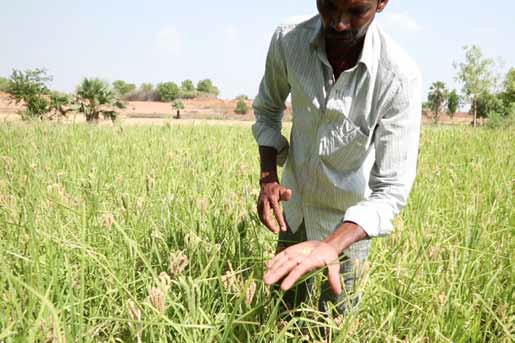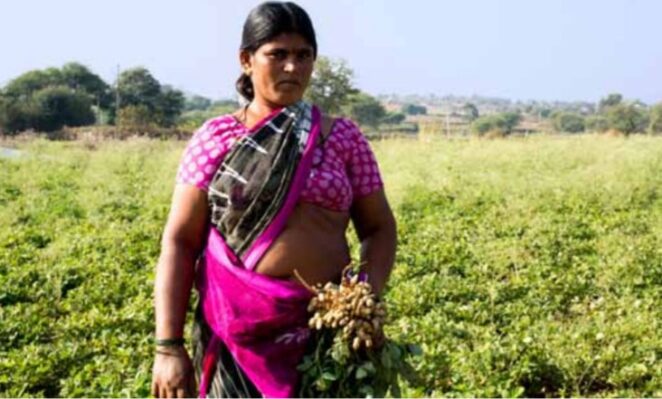Surviving Climate Change: an Approach to Planning and Implementation of Climate Change Adaptation in Rural Areas of India

Introduction
Of the 196 countries in the World, India has been ranked the most vulnerable to adverse impacts of climate change. Nearly two-thirds of India is drought prone, 12 percent is flood prone, and 8 percent is susceptible to cyclones.
India first developed the National Action Plan on Climate Change (NAPCC) in 2008. After a decision by the Prime Minister’s Council on Climate Change, states were tasked to develop their action plans in conformity with the national framework – the State Action Plans on Climate Change (SAPCC). The plans have both adaptation and carbon emission reduction actions to be undertaken at the state level. The SAPCCs are the first step towards decentralisation and effective implementation of India’s climate actions. Today, NAPCC and SAPCC serve as the guiding document to mainstream climate change concerns in sectoral plans and policies both at national and state level. To do so, it is incumbent now to make the policies work through a more granular level of democracy – districts, and even deeper at times at sub-district levels.
This publication presents the deployment of an adaptation initiative in four states in India.Telangana, Tamil Nadu, Punjab and Himachal Pradesh piloted an approach to climate-proof their public investments and development programmes for the future.
Relevant resources for each of the four states are included below. For more information see the climate vulnerabilities portal: http://climatevulnerability.in/
*Download the full publication from the right hand column. The key messages from the publication are provided below. See the full text for much more detail.
Climate Change Adaptation in Rural Areas of India
The Climate Change Adaptation in Rural Areas of India(CCA-RAI) projectworked with state nodal agencies on how to embed climate change priorities from the State Action Plans on Climate Changeinto policies and programmes at sub-national level. The project used a multi-pronged approach to facilitate policy guidance and help create an enabling environment to promote climate action. The multi-pronged approach focuses on three aspects: adaptation policy, capacity development and demonstration of adaptation activities (see below). This helped climate-proof current public investments and in turn found new ways to adapt that may not be part of existing development frame.
- Adaptation Policy: The project supported the development of State Action Plans on Climate Change at the sub-national level, helping to give overall policy guidance for adaptation activities and mainstreaming adaptation in various sectors.
- Capacity development was undertaken at multiple levels and ranged from one day sensitization formats for high level decision makers, 2-3 days targeted training on adaptation planning for sectoral departmental staff and 1-2 days training for communities.
- This work was based on the following adaptation hypothesis: Building the capacity of local multipliers spreads awareness and knowledge on adaptation. The training of government officials at multiple levels enhances their capacities to integrate climate change adaptation into planning process.
- Under this component numerous trainings were conducted at multiple levels and for different stakeholders, thus helping to build the capacity of local multipliers by spreading awareness and knowledge on adaptation. The training of government officials at multiple levels aimed to enhance their capacities to integrate climate change adaptation into planning processes and thus support SAPCC implementation.
- Demonstration of adaptation activities: This part of the approach focused on showcasing what adaptation means on the ground, and supporting implementation of concrete adaptation activities into development plans and processes based on the guidance provided by SAPCC at state level. This work also supported downscaling of SAPCC priorities to the local level.
The project found the entry points and built the case for action. It piloted such cases to understand implementation challenges, including a lack of capacity to understand local needs and thus develop evidence based adaptation solutions, a lack of funds for identified adaptation activities, and a lack of policy incentives for certain actions. It also provided proof of how these actions help to climate-proof public investments. Stakeholders were involved throughout the project, from inception to implementation to monitoring, to ensure their active engagement.
In the four states of Telangana, Tamil Nadu, Punjab and Himachal Pradesh, CCA-RAI has carried out state, district and sub-district level vulnerability assessments. This has helped build integrated plans for adaptation that identify actions, find convergence zones, identify financing opportunities, build capacities to deliver and establish adaptation-oriented monitoring mechanisms. In doing so, the project has established and run pilots in the four states, at both community level and at institutional levels.
Please refer to the full publication for more details on interventions in each four Indian States: Telangana, Tamil Nadu, Punjab and Himachal Pradesh.
Projects in four Indian States
Climate vulnerability assessments and numerous other resources can be found on the http://climatevulnerability.in portal.
Himachal Pradesh
The CCA-RAI project intervened in the district of Bilaspur in Himachal Pradesh to set up a pilot adaptation project. The pilot project helped to develop sustainable water management strategies in gram panchayat of Kandrour. The project worked with a local partner, CTRAN Consulting. The panchayat suffered from erratic rainfall, frequent droughts, crop failure, and high erosion. The farmers in the gram panchayat lived with high dependence on money lenders for credit, high productivity loss and poor crop production.
- Further reading:
Punjab
The CCA-RAI undertook pilot project in collaboration with local partner, Vasudha Foundation. The pilots were run in Patiala and Moga districts. Vulnerability assessment showed that the districts faced rising temperatures and extreme rainfall events.
The pilot supported farmers in taking up Direct Seeded Rice (DSR) through intensive interaction and provided them with technical knowledge and extension support. Additionally, in collaboration with Punjab Agriculture University (PAU), the project created a farmer’s network in Punjab to strengthen a platform which amplified the voices of conservation farmers.
Tamil Nadu
CCA-RAI joined hands with DHAN (Development of Humane Action) Foundation to lead pilots in Tiruvannamalai district in the state. The pilots projects dovetailed programmes such as Pradhan Mantri Krishi Sinchayee Yojana (PMKSY) and MGNREGA in the district, working with several line departments to deliver climate-proofing adaptation actions from within the development trajectory. The project helped treat the watershed in Jawadhu Hills to enhance soil fertility, reduce soil erosion and increase the water storage, with people’s participation.
- Further reading:
- Climate Change Impacts and Vulnerability Assessment in Tamil Nadu
- Tamil Nadu Climate Change Knowledge Portal– this portal includes details of the sensitisation and training programmes undertaken by CCA-RAI.
Telangana
A pilot intervention was undertaken in Mahbubnagar (erstwhile combined) district to show how climate vulnerabilities could be reduced to increase farmers’ climate resilience and incomes. Environment Protection Training and Research Institute (EPTRI) was the regional partner for the pilot.
The project helped farmers move towards growing groundnut, a traditionally grown crop, over rice as a more productive and suitable crop. The project further ensured timely supply of short duration drought resilient red gram seeds and groundnut by promoting community seed banks and seed replacements. A pilot intervention in partnership with Modern Architects for Rural India (MARI) also helped introduce better water management techniques for communites in the region.
- Further reading:

Please refer to the full publication for more details on interventions in each four Indian States: Telangana, Tamil Nadu, Punjab and Himachal Pradesh
Lessons Learnt
- Mainstreaming climate change adaptation at the local level is the most important aspect as it can help local governments at a ganular level, to deal with economic implications which can hinder the process of achieving development goals. The process can definitely be employed to inform evidence-based policy making at various levels.
- It is important to identify the right entry point aligned to existing developmental objectives/ plans/strategies at the local level driven by the requirements of the community and targeted to a specific problem/sectoral issue. The aim should be effective delivery of public services and associated management of natural resources.
- Local leadership or champions are crucial for building awareness on the need for mainstreaming climate change adaptation in ongoing and existing activities, driving adaptation action on ground and for ensuring sustainability of the interventions. It also depends on network participation and access to resources.
- Use of external catalysts such as the call for integrating adaptation concerns in key sectors, described as priorities in NAPCC, SAPCC and NDC, as a starting point for any action on ground and engaging with relevant stakeholders
- In some cases, like in Mahatma Gandhi National Rural Employment Guarantee Act, assured employment by building natural resource management projects can act both as an opportunity space, to mainstream climate change adaptation and act as a driver/incentive to promote adaptation action on ground to build natural capital.
- Mainstreaming climate change adaptation being an iterative process can only be effective if the measures and approaches are accountable. This includes defining clear goals, benchmarks and performance metrics to demonstrate results to communities, government and non-government partners, and demonstrable cost-effectiveness.
- Success depends on intensive stakeholder engagement in identifying the community requirements and ownership. Stakeholder involvement works best when perspectives from diversified stakeholders like scientists, local decision-makers, most vulnerable community members are included at all levels of planning and implementation.
Suggested citation
Awasthi, K. and S. Bhatt (2020). Surviving Climate Change: an Approach to Planning and Implementation of Climate Change Adaptation in Rural Areas of India. Deutsche Gesellschaft für Internationale Zusammenarbeit (GIZ) GmbH.
Further readings
Related resources
- Climate Change Information Portal for India
- Climate Change Adaptation in Rural Areas of India (CCA RAI)
- Accelerating Adaptation: State Action Plans on Climate Change as driver of mainstreaming climate change into development ...
- Mainstreaming Gender in Climate Change in India
- Climate Risk Management Framework for India: Addressing Loss and Damage (L&D)
- From Margins to Mainstream? State Climate Change Planning in India as a 'Door Opener' to a Sustainable Future
- Strengthening disaster risk management in India: A review of five state disaster management plans
- Policy brief: How do gender approaches improve climate compatible development? Lessons from India
(0) Comments
There is no content